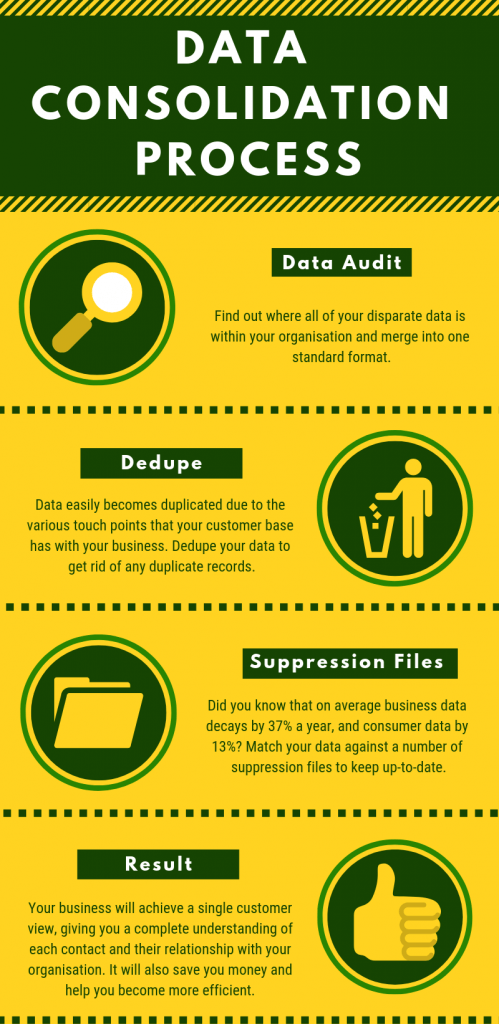We all have such a busy working life that having a good old clear out of your company data probably doesn’t cross your mind. That said, a clean home is a happy home, as the saying goes, and why should your business and its computers be treated any differently? Today’s lesson is about data consolidation.
In 2019, you will have noticed that data is widely becoming a trending topic. GDPR this, data breach that, it’s never ending. If you’re a business that compiles large volumes of data, then answer us this: When was the last time you took a really hard look at all your data resources?
If you cannot remember, or the answer is never, then we would advise the following: that you merge all your data to see what exactly you have. If you’re unsure of the best way in which to achieve this, then below is a process which we think is the optimum way of consolidating your database.

1. Conduct a Data Audit
First things first, you should conduct an audit of your database in order to find out what records you have and also whereabouts they are. A data audit is one of the most effective ways to identify problem areas in your marketing, data storage, and your overall business operations. When you take a good, hard look at your data assets and how they’re used, you can easily see where money is being wasted, and how to strategically increase your profits. Hopewiser would recommend you carry out a data audit to find all the disparate data you have within your organisation.
You may already have software at your disposal that can merge your datasets into one standard format, also known as a master file. In which case, you’re good to go. For those of you who don’t, however, a company who specialises in data cleansing will be more than capable of helping you out.

2. Deduplicate Your Data
Once you have audited your data and merged your records into one standard format, deduplicating your now single database will remove any duplicate entries.
For example, you may have duplicate entries for a customer containing both their current and previous addresses. This does not bode well if you need to contact them urgently or when you’re conducting a marketing campaign, as you may send their mail to the wrong address, or contact them multiple times. When you start the deduping process, you will be able to pick up on such discrepancies.

3. Match Your Data Against Suppression Files
Now that your company records are merged and deduped, the next crucial step towards a consolidated database is matching your records against a series of suppression files. This will highlight exactly who in your database has either died or moved house. Additionally, it will also flag up anyone registered with marketing preference services. This is extremely important from a data integrity point of view because marketing to those who have sadly passed away, moved addresses, or are registered with the MPS and TPS will not do your brand image any favours. Additionally, your conduct may come under fire if you’re found to have used your customers’ personal data in a way that breaches current legislation.
A data cleansing tool will not only indicate the deceased, mover, and opt-out records in your files, it will also remove the unnecessary details. You can then continue using your database with peace of mind that your business is operating in both an effective and compliant manner.
4. The Result
Having completed the aforementioned steps of the consolidation process, the result will be a single customer view of the data you hold. A single customer view will give you a complete understanding of each individual contact and their relationship with your organisation. It will provide your organisation with easy access at any time to your central data source, not to mention that it saves on operating expenses and staffing levels.
An example of where Hopewiser was able to help a large organisation consolidate their database was with an FTSE 100 company who wanted achieve a significant reduction in costs, maintain or improve their existing service level agreements, and to utilise emerging technology to the best effect.

The client originally operated a complex IT infrastructure with multiple instances of Royal Mail PAF data across several different applications. Every separate instance incurred a royalty fee, the sum of which totalled to quite a considerable amount of money. Hopewiser was able to consolidate all of the disparate records from various systems and servers into one Corporate Licence. This in effect saved the client significant amounts of money on both their Royal Mail fees and address management software costs. The overall outcome was that the company achieved a single customer view, enabling them to carry out their business operations to the highest of their ability through the convenience and security of a centrally controlled Master Address File.
However you intend to clean out your computer today and in the future, consolidating your database and having a single customer view will certainly help to improve the efficiency of your business.
, updated 31st July 2019.
Topic: DataSingle Customer View






